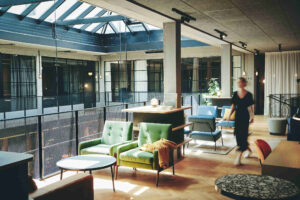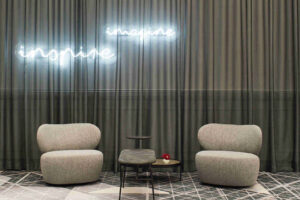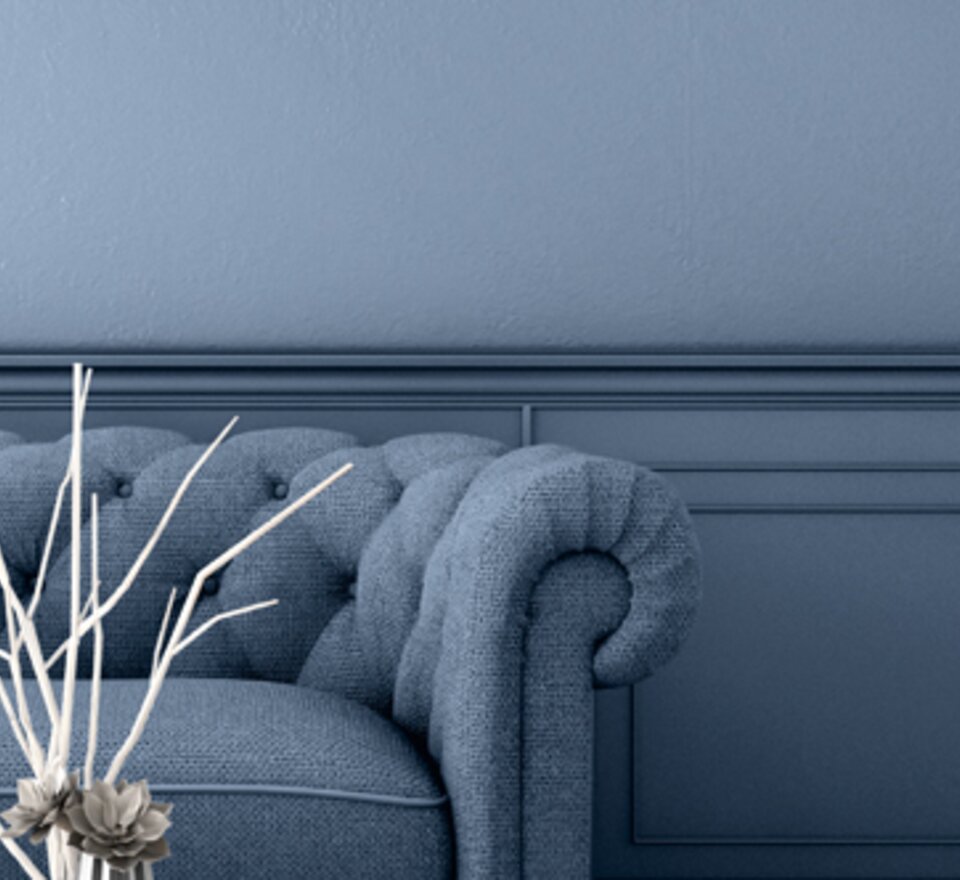Hotels play an important role in providing the market with meeting and conference facilities. However, thanks to COVID and the ever-increasing digitalisation of business communications, the situation has changed dramatically. Here we take an encouraging, inspiring look at the conference rooms of the future.
It’s like sitting in a factory loft through which a quick blast of Modern Talking and Miami Vice has just blown for a few seconds. On the one hand, big factory windows, exposed Spiro ventilation ducts and a rather rough ceiling made of grey insulated boards. On the other, dark, concrete-grey walls and a grey and purple checked carpet in a chessboard design that looks a bit like an unfortunate post-modern, chromatic aberration. All that’s missing are the clouds of smoke from which Thomas Anders and Don Johnson will suddenly emerge. “The days of only providing the basics, in traditional multipurpose rooms, completely lacking in atmosphere and character, are over,” says Erich Bernard, Managing Partner at Vienna-based architects BWM. “Before COVID, when the conference hospitality sector was still riding high and demand exceeded what the market could supply, there wasn’t really any competition. But in a very short time, COVID has turned a supplier’s market into a buyer’s market. To succeed in today’s event industry, you need to be inspired!” A few months ago, BWM finished the new Hotel Gilbert in the Breite Gasse, just a stone’s throw from Vienna’s museums district, and in September there was an Open House event to show off the refurbishment project. The hotel, a crossover between “urban stay” and “industrial luxury”, has 56 rooms and, at its heart, a glass-roofed, light-filled lobby with a bar, restaurant and cosy chill-out lounge, complete with fireplace and retro tiles. Adjacent to it, slightly raised up on the first floor, with huge windows and a gallery running round one side, are two conference rooms for twelve and 30 people, respectively.

BWM Hotel Gilbert; © BWM Architekten Michael Königshofer
Even more dramatic, even more enticing, is the Marriott that BWM built on the Potsdamer Platz in Berlin (2018). Lit up in neon lights behind a thin curtain in the main conference hall are poetic words associated with meetings: connect, inspire, imagine, celebrate. In the pre-function and break-out rooms, on the other hand, BWM created an Art Deco feel, with dark wood veneers, highly polished floors, plush velvet upholstery, golden-coloured furniture and geometric designs on the walls, reminiscent of the Chrysler Building, the Great Gatsby and the Roaring Twenties in New York.
“It needs to be warm, plush and really cosy,” says Bernard. “Clients and conference attendees long for colour and textiles, for comfortable, laid-back, low seating – and for multifunctionality that works perfectly, but is hidden behind the appearance of a lovely, homely living room.” And unlike in earlier years, says the architect, the break-out and pre-function rooms are also becoming more and more important. “No, this isn’t wishful thinking or a construct of architectural theory – it’s the reality. I haven’t attended a single conference since COVID that left me cold in terms of the space it took place in. Most of the events were held in pretty sensational locations, often with fantastic views of the city or the scenery. There’s tremendous competition now. In the age of Zoom and online conferences, only the best will survive.”
This is confirmed by Susanne Baumann-Söllner, Vice-President for Congress Management at the Internationales Amtssitz- and Konferenzzentrum Vienna (IAKW – International HQ and Conference Centre) and also spokeswoman for the Board of the ACV Austria Center Vienna, by far the biggest conference centre in Austria. “Architecture – and the specific spatial and technical experience that it provides – is becoming more and more important, because the role of conferences is not just to share knowledge but also to enable people to network and enjoy sensory experiences that are outside their normal everyday working lives. In the wake of COVID and the unstoppable march of online communication, the value of meeting together in person has become even greater.”
And for Christiane Unawatuna Hewage, Director of MICE at Verkehrsbüro Hospitality, the technical equipment and the rooms and online services that are available are all-important: “In the past, conference rooms in the hospitality sector were generally booked up a year in advance. Now, though, bookings can come rolling in just two or three months before the event. This means that the cancellation terms have changed, and of course hotels nowadays need to be able to react very spontaneously to last-minute alterations.”
Will the event actually happen? Is it a purely analogue event or a hybrid one? How well-prepared are you to respond to any new government regulations, for example on hygiene, social distancing or providing refreshments? And what can you do if the conference is going to take place entirely online? At the Austria Trend Hotel Savoy near the Botanical Gardens and the Belvedere, during the pandemic in 2020 they sacrificed one traditional suite and turned it into a streaming suite – with a sound-insulated media room, a control room, two lecture rooms and even a dressing room for the speakers.

Marriott Hotel; © BWM Architekten Wolfgang Zlodej
Another important aspect is the question of environmental sustainability, which affects the conference sector as much as everyone else. “In my experience, many big companies will only organise their conferences and symposia in venues where they can say it is a certified Green Meeting,” says Michaela Reitterer, owner of the Hotel Stadthalle and, until the start of this year, long-term President of the Austrian Hoteliers Association (ÖHV). “I would advise all hotels and hoteliers to invest accordingly, if they want to remain successful in the market.” The German hotel expert Maria Pütz-Willems, publisher of the industry newsletter Hospitality Inside, makes this point even more strongly: “The semi-professional family hotel that just has one meeting room somewhere, equipped with whatever comes to hand, has had its day. Because big, listed companies that have made a commitment to their shareholders and stakeholders that they will meet certain environmental governance standards, and have to prove regularly that they are acting sustainably, simply can’t even approach a hotel anymore which doesn’t have green certification. The hotel industry would be well advised to adapt its conference facilities as quickly as it can.” The key aspects of green certification include being accessible on public transport, providing a suitable transport option for the final mile, reducing packaging on food, goodies and give-aways, using as little plastic as possible, running on green energy and generally being resource-efficient in energy consumption, sourcing food that is local and seasonal and if possible even has a social benefit, using eco-friendly cleaning materials and ensuring that the hotel’s overall CO2 footprint is low and transparent to all. “And what I’m seeing in the market,” says Pütz-Willems, “is that it’s not just the big players with 4- and 5-star hotels in the cities who have invested in this.
Many medium-sized family-run companies have already done so as well, such as Lindner Hotels and even budget chains like Ruby Hotels. And classic holiday parks like Center Parcs and Club Med are also increasingly understanding the relevance of conferences and online working. It’s no wonder, because the WiFi on the back of an elephant somewhere in the jungle in Thailand is probably more stable than it is here in Germany.” Especially in the budget sector, more and more interesting hospitality products and business services keep popping up. For example, the budget chain Ruby Hotels has created a sister company, Rubyworks. This offers separate co-working spaces and conference facilities for hire that can be made available to both non-residents and hotel guests. Pütz-Willems: “The Rubyworks locations are usually only a few minutes’ walk from a Ruby Hotel. The service has gone down very well and I think it’s a smart and intelligent reaction to the trend over the last two years.” The market has become very difficult and during the lockdowns it seemed to be on its knees, but the conference business is not going to die out – all my interviewees agree on that. “There’s a strong analogue longing in us all,” says BWM architect Erich Bernard. “Alongside all the online formats and digital meetings, we still want to have post-its, flip-charts, graphic recording and physical closeness back again. Our task as architects in designing hotels and interiors is to make sure that these settings for synergy work well and, above all, give people pleasure, even more so than they did before.”
Wojciech Czaja

